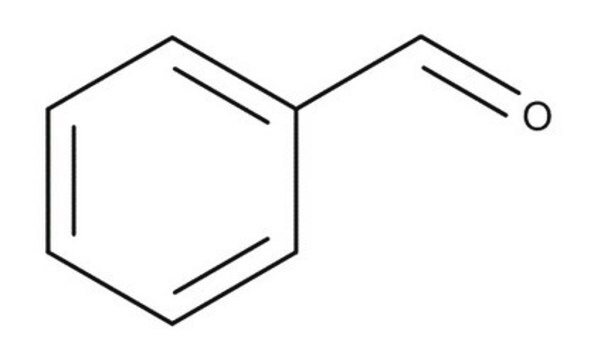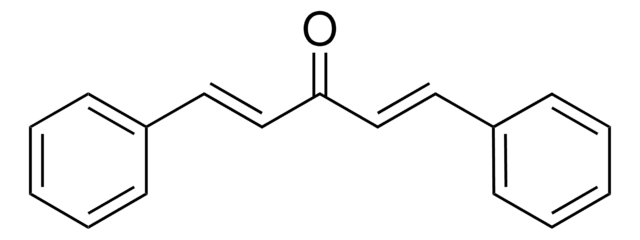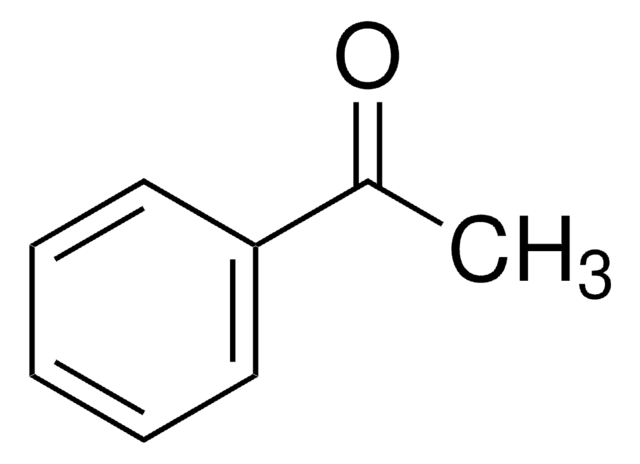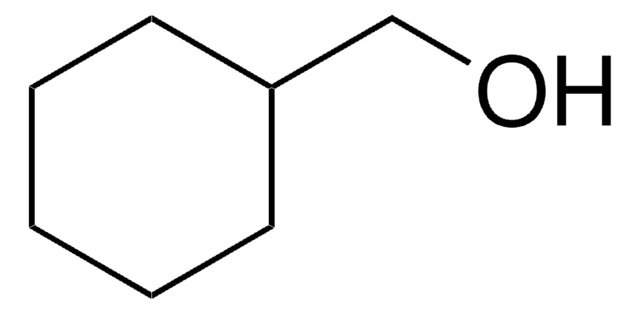B1334
Benzaldehyde
ReagentPlus®, ≥99%
Sinónimos:
Bitter almond
About This Item
Productos recomendados
densidad de vapor
3.7 (vs air)
Nivel de calidad
presión de vapor
4 mmHg ( 45 °C)
Línea del producto
ReagentPlus®
Análisis
≥99%
formulario
liquid
temp. de autoignición
374 °F
lim. expl.
1.4 %, 20 °F
índice de refracción
n20/D 1.545 (lit.)
pH
5.9 (20 °C)
bp
178-179 °C (lit.)
mp
−26 °C (lit.)
densidad
1.044 g/cm3 at 20 °C (lit.)
cadena SMILES
O=Cc1ccccc1
InChI
1S/C7H6O/c8-6-7-4-2-1-3-5-7/h1-6H
Clave InChI
HUMNYLRZRPPJDN-UHFFFAOYSA-N
¿Está buscando productos similares? Visita Guía de comparación de productos
Descripción general
Aplicación
- Preparation of optically active 1-phenylpropan-1-ol.
- Synthesis of meso-tetraphenylporphins and chlorins.
- As a test compound to study oxidative amidation reaction of aliphatic primary/secondary amines using N-heterocyclic carbine as a catalyst.
- Synthesis of 2-phenyl-2,3-dihydro-4H-pyran-4-one with high enantioselectivity by hetero-Diels-Alder (HDA) reaction with Danishefsky′s diene.
Calidad
Información legal
Palabra de señalización
Danger
Frases de peligro
Clasificaciones de peligro
Acute Tox. 4 Inhalation - Acute Tox. 4 Oral - Aquatic Chronic 2 - Eye Irrit. 2 - Repr. 1B - Skin Irrit. 2 - STOT SE 3
Órganos de actuación
Respiratory system
Código de clase de almacenamiento
6.1C - Combustible acute toxic Cat.3 / toxic compounds or compounds which causing chronic effects
Clase de riesgo para el agua (WGK)
WGK 1
Punto de inflamabilidad (°F)
145.4 °F - closed cup
Punto de inflamabilidad (°C)
63 °C - closed cup
Equipo de protección personal
Eyeshields, Faceshields, Gloves, type ABEK (EN14387) respirator filter
Elija entre una de las versiones más recientes:
¿Ya tiene este producto?
Encuentre la documentación para los productos que ha comprado recientemente en la Biblioteca de documentos.
Los clientes también vieron
Artículos
The aldol condensation reaction is an organic reaction introduced by Charles Wurtz, who first prepared the β-hydroxy aldehyde from acetaldehdye in 1872.
Knoevenagel Condensation is an organic reaction named after Emil Knoevenagel. It is a classic C-C bond formation reaction and a modification of the Aldol Condensation.
Nuestro equipo de científicos tiene experiencia en todas las áreas de investigación: Ciencias de la vida, Ciencia de los materiales, Síntesis química, Cromatografía, Analítica y muchas otras.
Póngase en contacto con el Servicio técnico











